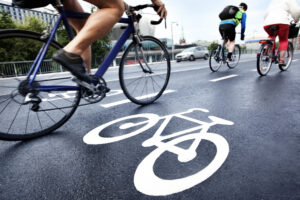 There’s no doubt about it: 2020 will always be remembered for a once-in-a-lifetime pandemic that disrupted our lives in every way imaginable. Fortunately, with vaccines in place, we appear to be heading in the right direction. One thing we learned from the past year is that outdoor exercise has never been more important. More people have taken up cycling to stay healthy and get outside. Many of us look forward to early morning group rides; others just enjoy the ride around town as a healthy and environmentally-friendly way to get from point A to B. Back in the day, when I called myself a cyclist – (see picture for proof; yes, that’s a younger me!) – I did not think much about the legal rights of cyclists: I just wanted to get my miles in and have a good time. Now that my cycling days are more hobby than pro, and I have a wife who also loves cycling and two kids getting started, I view cycling through an entirely different lens – as a husband, dad, and, yes, lawyer (see that picture, too!). So I wanted to share some quick Cycling Law 101 and let you know we are here for you if you or a friend needs a lawyer.
There’s no doubt about it: 2020 will always be remembered for a once-in-a-lifetime pandemic that disrupted our lives in every way imaginable. Fortunately, with vaccines in place, we appear to be heading in the right direction. One thing we learned from the past year is that outdoor exercise has never been more important. More people have taken up cycling to stay healthy and get outside. Many of us look forward to early morning group rides; others just enjoy the ride around town as a healthy and environmentally-friendly way to get from point A to B. Back in the day, when I called myself a cyclist – (see picture for proof; yes, that’s a younger me!) – I did not think much about the legal rights of cyclists: I just wanted to get my miles in and have a good time. Now that my cycling days are more hobby than pro, and I have a wife who also loves cycling and two kids getting started, I view cycling through an entirely different lens – as a husband, dad, and, yes, lawyer (see that picture, too!). So I wanted to share some quick Cycling Law 101 and let you know we are here for you if you or a friend needs a lawyer.
“Share the Road.” In light of Georgia law, the sticker should probably read “We Share the Road.” O.C.G.A. § 40-1-1 deems bicycles as “vehicles,” and cyclists are generally subject to the rules of the road. O.C.G.A. § 40-6-56 provides that Georgia drivers must leave a “safe distance,” defined as at least three feet, between the car and the cyclist he or she is passing. Cars cannot “buzz” cyclists; if a driver cannot leave three feet, he or she cannot pass. In turn, a cyclist must generally stay as far as safely possible towards the right side of the lane (with some exceptions). On very narrow roads, a cyclist may lawfully take up more of the lane if he or she uses reasonable care and follows all other regulations. Long story short: the cyclist is using the lane and has a right to do so. Some proposals now before the General Assembly, House Bill 353 in particular, would require vehicles to pass cyclists in another lane if possible or, if not, slow to a safe speed and pass while giving at least three feet. O.C.G.A. § 40-6-294 provides that cyclists in a group must generally ride “double file,” that is, no more than 2 abreast, except when riding in specified bike lanes or paths or when a special event allows cyclists to ride more than two side-by-side. Georgia law prohibits cyclists from riding on sidewalks; it also requires cyclists riding at night to have a front headlight visible from 300 feet and a rear red reflector. As I said earlier Georgia law provides that cyclists and automobiles in fact Share the Road.
When auto and cyclist collide.
If you are hit by a vehicle while cycling, of course you will call 911, get medical attention, make a police report, and (hopefully) preserve as much available evidence as you can. But who pays the bills and damages? How does automobile insurance come into play? And what happens if a careless driver flees the scene or has little to no insurance? Who will cover the costs of medical treatment and personal injury and property damage? Bicycle-specific insurance policies are rare. While the at-fault driver’s liability insurance will generally be the primary (first to pay) insurance, the at-fault limits are often not nearly enough. For that reason, the cyclist’s own automobile or motorcycle uninsured/underinsured motorist (“UM”) coverage (yep, even if a car or motorcycle was not involved in the wreck) will typically become the secondary insurance and often provide the best avenue to get coverage. UM coverage is a type of insurance that covers an injured driver, or cyclist, if the at fault driver is uninsured (has no insurance) or underinsured (has insurance but not enough to cover the injured party’s damages). It’s required to be included in most auto policies unless expressly rejected in writing. If a cyclist is injured, the cyclist’s UM coverage from the cyclist’s auto policy may provide the cyclist with money for injuries. A lot of cyclists are shocked to learn that their auto policies, and maybe the auto policies of other resident relatives in the same household, will provide benefits when they are hit while riding a bike and their own car is in no way connected to the wreck. It is worth looking at your auto insurance policies and talking to your insurance professional concerning your UM limits in your auto policies before you have a wreck. If you are injured in a cycling wreck, notify your insurer without delay: you never know if the at-fault driver has enough (or any) insurance. I encourage you to become familiar with the bicycle laws in Georgia and your auto UM limits.
Here’s hoping that all your rides are safe and enjoyable. But if they’re not, make sure you talk to a competent cyclist attorney as soon as possible– one who happens to have a lot of cycling experience is not a bad idea either. Keep the rubber side down, ride safely and defensively. Reid (39), is an attorney at Norris Injury Law, he and his wife, Catherine, live and work in Athens, GA, and enjoy cycling together and with their son, Huxley, and daughter, Josie Lou.
We’re here to help if you need us. 1143 Prince Ave, Athens, GA
30606 706-420-6400
www.NorrisInjuryLaw.com “Injury Law, Y’all!”®




